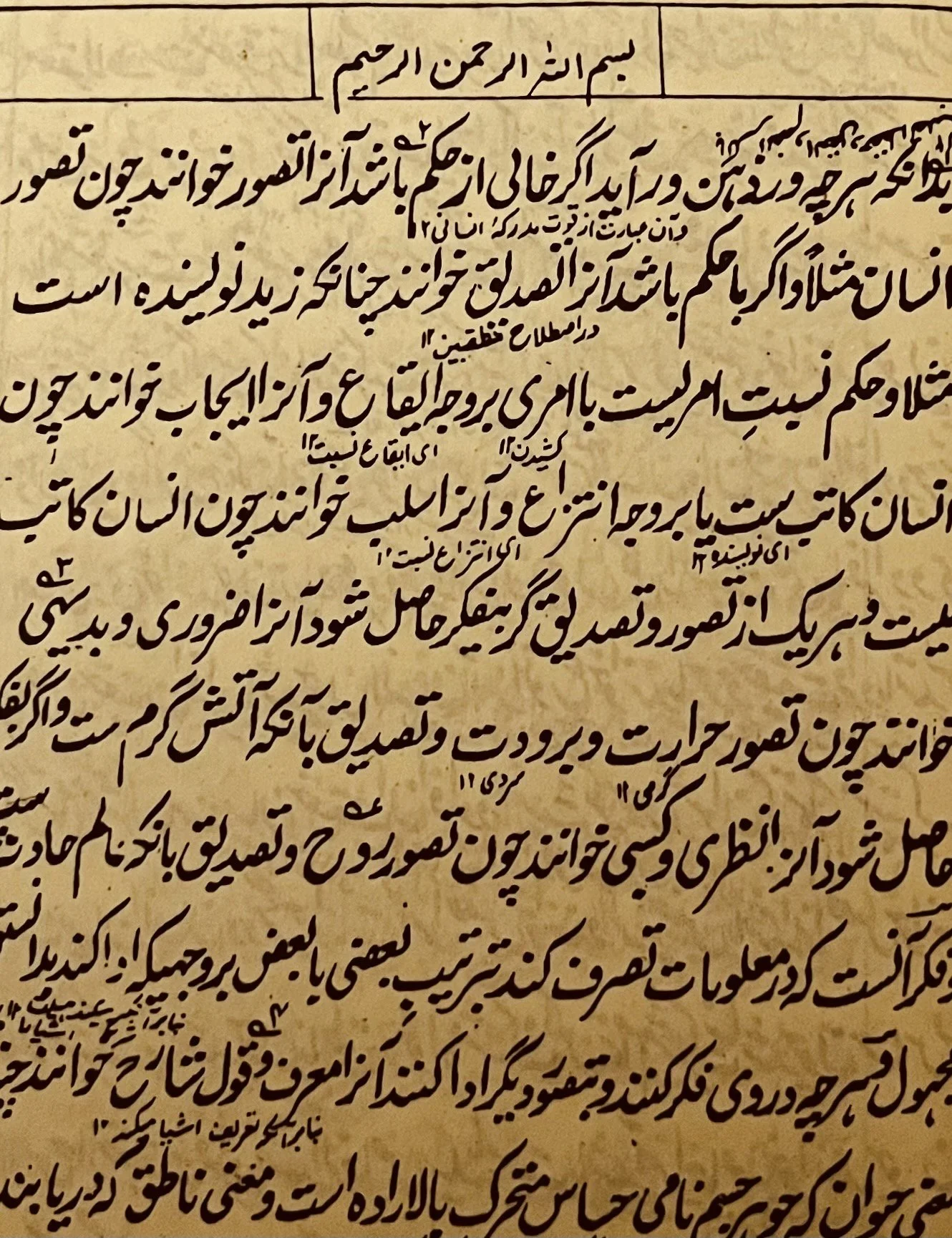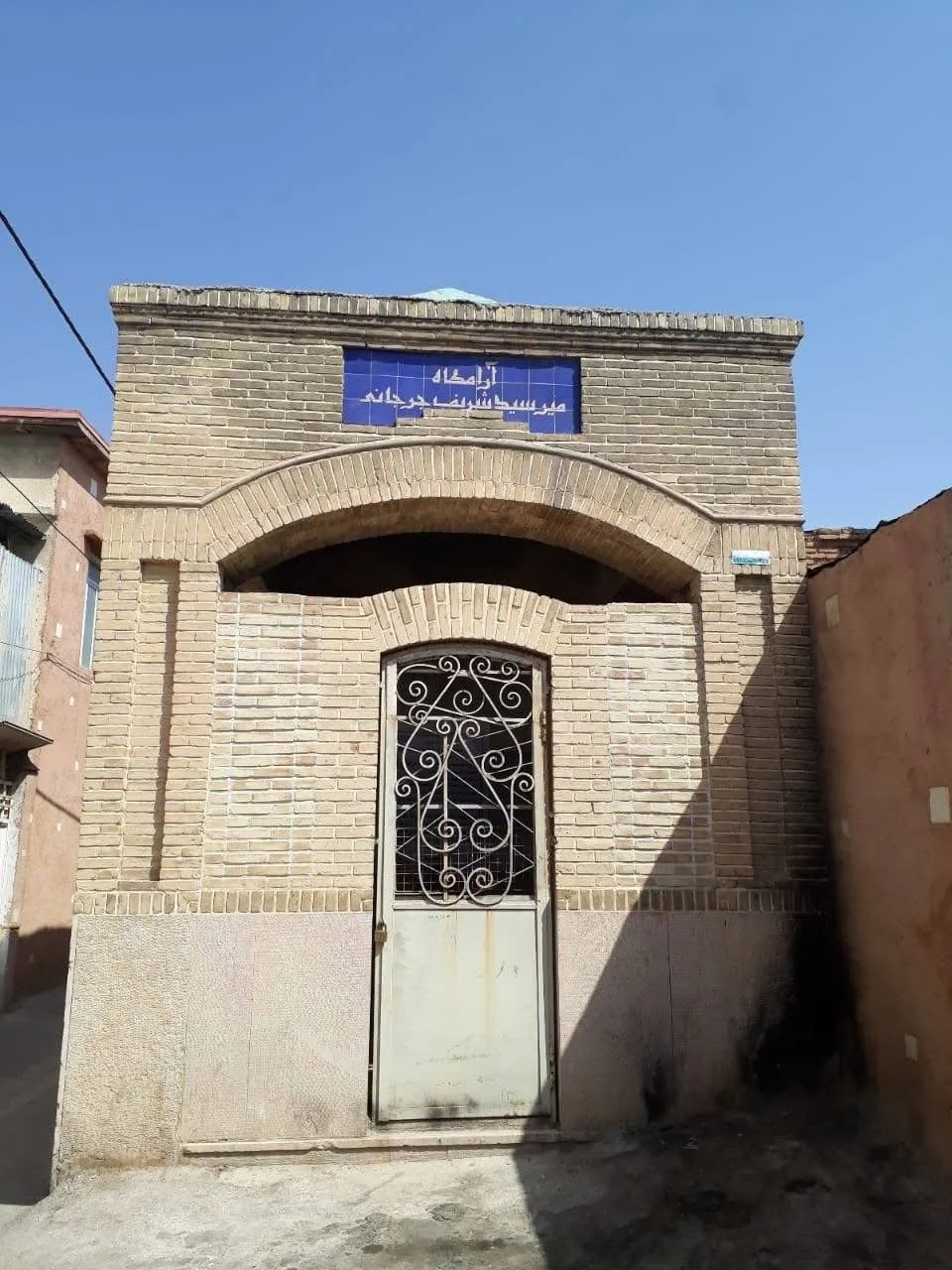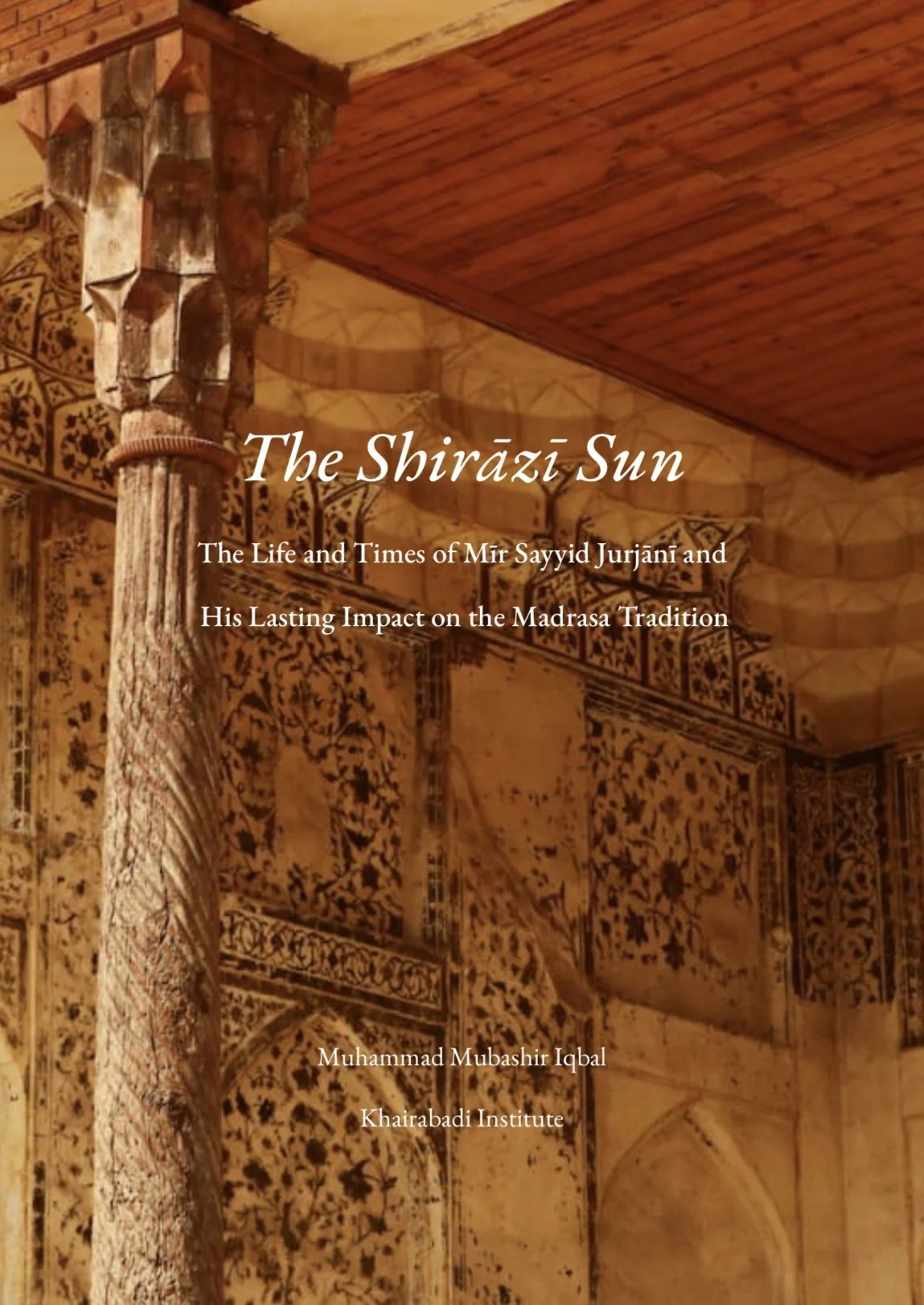NEW COURSE AT KHAIRABADI INSTITUTE
Ṣughrā and Kubrā in Logic
Mīr Sayyid Sharīf Jurjānī
Two Core Curricular Treatises in the Farangī Maḥall & Khairabādī Traditions
A Complete Study of Two Foundational Texts in Logic — in Persian and English
Course Overview
Have you ever felt that you haven’t fully grasped the mechanics of logic as a student of sacred knowledge?
Perhaps you’ve studied the qawāʿid (rules), yet still sense gaps in your understanding.
You may not fully appreciate the purpose of the subject, or you feel that your learning journey has left certain spaces unfilled.
You might know everything about conceptions (taṣawwurāt), yet not understand what it truly means within the larger framework of the science.
Ṣughrā and Kubrā address all of these concerns in a way that Mīr Sayyid, writing from within the late-classical tradition, was uniquely positioned to offer. He teaches you the rules of logic while giving it shape as a coherent and purposeful discipline.
The main benefit of this programme is that it illustrates how logic works, how it should be approached, and the method by which it is best studied. It lays a clear foundation and framework for further study in manṭiq, within the late classical tradition of the Farangī Maḥall.
A central outcome is to provide students with a solid and gapless grounding in the science, one that builds a coherent narrative and a clear pedagogy of study. The aim is to equip learners with a roadmap toward the higher levels of the classical Muslim curriculum.
By taking this course, students will unlock a number of key logic texts appropriate to the level of the works studied in this programme, and be prepared to move on to more advanced texts in late-classical syllabi.
This programme is designed to ensure that students emerge with a confident, structured understanding of logic, and are recognised as having a strong and reliable foundation in the discipline.
Style of Study
Ṣughrā and Kubrā will be taught in accordance with the Khairabādī pedagogy and method. Students will be expected to prepare the upcoming passages, to the best of their ability, in advance. The instructor will then deliver a Khairabādī-style lecture, opening up the meanings of the text and clarifying the objectives of the author for the students. This lecture will then be fitted back into the text completely. Afterward, students will be required to memorise the lecture and demonstrate their ability to apply its insights back into the text themselves. In the tutorial sessions, students will also be expected to recite by memory the modules studied.
-
The primary text of study will be Kubrā. After completing each unit, students will return to the same topics in Ṣughrā, allowing them not only to review what they have previously learned but also to recognise how their understanding and malakah (intellectual acuity) have developed. Through this reading of Ṣughrā, they will complete a second Farangī Maḥall primer, one that will also demonstrate, in practice, that they can now read and understand other works in mantiq with ease. Moreover, this second reading is purposeful: it prepares students to eventually teach Ṣughrā as a foundational primer in logic for others.
The instructor will teach both texts in their original Persian. While an English translation of each text will be provided to students, the instruction will remain rooted in the Persian itself, delivered in a precise yet accessible manner. As a result, students will not only engage with the texts in their authentic form, but will also, as a natural outcome, acquire a significant grasp of the Persian language by the end of the programme.
MESSAGE FROM OUR PEERS
“Mawlana Mubashir is inspired and inspiring…”
“Mawlana Mubashir is a person of high aspiration for serving tradition and embodying its high meanings…”
— Shaykh Mustafa Styer
Course Outline
-
Unit 1: Introduction to Conceptions and Assertions
INTRODUCTION TO CONCEPTIONS AND ASSERTIONS
THREE RELATIONS OF ASSERTION
Unit 2: Taxonomy of Knowledge and Intellectual Examination
TYPES OF CONCEPTIONS AND ASSERTIONS
INTELLECTUAL EXAMINATION
DISTINCTION BETWEEN HUMANS AND ANIMALS
DEFINING SPEECH AND EVIDENTIAL ARGUMENT
Unit 3: Indications and the Principles of Signification
INDICATION AND ITS TYPES
VERBAL SIGNIFICATIONAL INDICATION AND ITS TYPES
TOTAL CORRESPONDENCE, PARTIAL INCLUSION AND NECESSARY IMPLICATION
INDIVISIBLE AND COMPOSITE
Unit 4: The Logical Classification of Meaning: Conception and Assertion
REAL AND METAPHOR
TYPES OF WORDS
SIMPLE EXPRESSIONS AND COMPOSITE EXPRESSIONS
TYPES OF SIMPLE EXPRESSIONS
TYPES OF COMPOSITE UTTERANCES
CLASSIFYING EXPRESSIONS INTO CONCEPTIONS AND ASSERTIONS
Study of Foundational Epistemics of Logic in Sughra
Note: Each unit is further divided into several modules.
-
Unit 5: Universals and Particulars — The Structure of Conception
PARTICULAR AND UNIVERSAL
FIVE UNIVERSALS
Unit 6: Consolidating the Structure of Universals
RELATIVE SPECIES
SPECIFIC PROPERTY AND GENERAL ACCIDENTS
Note: Each unit is further divided into several modules.
-
Unit 7: Classification of Expository Speech and Its Principles
DEFINITIONS AND DESCRIPTIONS
METAPHORS AND HOMONYMS IN DEFINITIONS
DIFFERENTIATION BETWEEN UNIVERSALS
Study of the Five Universals in Sughra
Note: Each unit is further divided into several modules.
-
Unit 8: Structures and Classification of Propositions
INQUIRY ON PROPOSITIONS
TYPES OF PROPOSITIONS
TECHNICAL NAMES FOR PARTS OF PROPOSITIONS
Unit 9: Complex and Modal Structures in Propositions
TYPES OF ATTRIBUTIVE PROPOSITIONS
SIGNIFICANT PROPOSITIONS IN PHILOSOPHICAL SCIENCES
METATHETIC AND DETERMINATE PROPOSITIONS
MODAL PROPOSITIONS
Unit 10: Conversion and Contradiction of Propositions
CONVERSION OF QUANTIFIED PROPOSITIONS
CONTRADICTORY OF PROPOSITIONS
TYPES OF CONDITIONAL PROPOSITIONS
CONTRADICTION AND CONVERSION OF CONDITIONAL PROPOSITIONS
Study of Propositions in Sughra
Note: Each unit is further divided into several modules.
-
Unit 11: Evidential Reasoning and the Structure of Syllogism
TYPES OF EVIDENTIAL ARGUMENTS
SYLLOGISM AND ITS TYPES
CONNECTIVE SYLLOGISM AND ITS TYPES
Unit 12: Productive Moods in the Figures of the Syllogism
CONDITIONS FOR PRODUCTIVE MOODS OF THE FIRST FIGURE
CONDITIONS FOR PRODUCTIVE MOODS OF THE SECOND FIGURE
CONDITIONS FOR PRODUCTIVE MOODS OF THE THIRD FIGURE
Unit 13: Structure of Syllogism: Exceptive Syllogism and Its Types
TYPES OF EXCEPTIVE SYLLOGISM
The Study the Evidential Argument in Sughra
Note: Each unit is further divided into several modules.
How will the course be delivered?
The course is divided into five Integrals, each further broken down into a series of units that generally correspond to sections of the book. Each unit contains a set of modules, a live tutorial class, a question submission page, additional study resources, carefully designed SAT-style questions, and an assessment.
The modules are delivered as short, pre-recorded videos, each focused on a specific concept or idea drawn from a particular point in the book’s broader discussion. Each video includes the teacher’s lecture (taḳrīr), a clear diagrammatic summary of the lesson, and both the original Persian text and its corresponding English translation.
Students are given a set window of time - typically two weeks per unit - to complete their study of the modules. After this, they will complete the SAT-style questions, assessments, and memorisation requirements. This structure allows students to apply what they have learned in a formal setting, while giving the teacher an opportunity to assess comprehension.
Each unit concludes with a live, seminar-style tutorial discussion, allowing the instructor to engage directly with students, observe their progress firsthand, and reinforce the material covered.
Read More on Khairabadi Institute's new path to online Islamic Education here
“I had the honour of studying Sughra and Kubra of Mir Syed Sharif Jurjani with our beloved teacher Mawlana Mubashir. It was an immense learning experience and helped me ground myself in mantiq.
It also helped me to have a glimpse of the maqoolat tradition and its significance in today’s world. I would recommend this for any sincere student of knowledge who wants to benefit from our tradition”.
Abu Taha, Lecturer, University of Westminster
About the Author: Mīr Sayyid Jurjānī
Mīr Sayyid Sharīf al-Jurjānī (d. 816 AH / 1413 CE) was one of the most influential Muslim scholars of the late-classical period. Born near Astrābād (Gorgan) in Iran, he was a Ḥusaynī in lineage, Ḥanafī in jurisprudence, Ashʿarī in creed and a muḥaqqiq by temperament (mizāj). His thirst for knowledge took him from his homeland to the great centres of learning in Herat, Anatolia, and Cairo, where he studied with luminaries such as ʿAllāmah Mubārak Shāh al-Manṭiqī and ʿAllāmah Akmal al-Dīn al-Bābartī. He came to be widely known in the lands beyond the river (Transoxiana) as Mīr Sayyid Sharīf, and among the Arabs as al-Sayyid al-Sharīf. Other well-known honorifics include al-Sayyid al-Sanad and Mīr Sayyid.
After years of study and travel, Mīr Sayyid settled in Shiraz and later in Samarkand, where he taught, issued fatwas, and produced many of his celebrated works. He engaged in scholarly discussions with leading contemporaries, including ʿAllāmah al-Taftāzānī, and his intellectual authority was acknowledged across the Muslim world. A master of both the rational and transmitted sciences, he combined his wide-ranging expertise with spiritual refinement, later affiliating with the Naqshbandī sufi order.
His writings became central to the madrasa tradition for centuries. From primers in grammar and logic to advanced works in kalām and philosophy, Mīr Sayyid’s texts shaped the curricula of Ottoman madrasas, al-Azhar, the Farangī Maḥall tradition in South Asia, and the Khairābādīs. His commentary Sharḥ al-Mawāqif in theology and his primers Ṣarf-i Mīr, Naḥw-i Mīr, Sughrā and Kubrā are only a few examples of works that became indispensable in the training of scholars across the Muslim world.
Mīr Sayyid al-Jurjānī passed away in Shiraz in 816 AH / 1413 CE, yet his influence endured for centuries, with his works studied continuously well into the modern era. He was not only a prolific author but a muḥaqqiq (verifying scholar) and a polymath for all seasons. His intellectual precision, pedagogical clarity, and breadth of vision make him a timeless figure whose contributions remain urgently relevant in today’s age of confusion, and the widespread neglect of thorough study in the Islamic sciences.
For a more in-depth reading of the lifes and times of Mīr Sayyid Sharīf al-Jurjānī, and his impact on the Madrasa Tradition, click here.
About the Texts
Risāla-i Ṣughrā:
This is short introductory handbook on logic in Persian, known as Ṣughrā (‘Minor’), to distinguish it from the slightly longer introduction, Kubrā. The text is preserved within the compendium Majmūʿa-i Manṭiq and is arranged into three sections. Mīr Sayyid Jurjāni first authored it for his young son as a text to be committed to memory. Within the Farangī Maḥall curriculum, it served as the introductory text in logic, falling under the fann of manṭiq sāzaj (simple logic).
Note: In most madrasas today, the first text in logic taught is Isāghūjī. While this is a highly regarded and precise work, its topics and objectives can be challenging for beginners to grasp. By contrast, Risāla-i Ṣughrā offers an ideal introduction to the study of logic, owing to its novice-friendly layout, clarity, and highly concise form, which lends itself well to memorisation.
Risāla-i Kubrā:
This is the second work taught in the Farangī Maḥall curriculum for logic and, like Ṣughrā, is preserved in the compendium Majmūʿa-i Manṭiq. It serves as a longer introductory handbook on logic in Persian, titled Kubrā (‘Major’), distinguished from the previously mentioned Ṣughrā. It appears to have been a popular introduction in the Persian-speaking world, inspiring a number of commentaries in later centuries. In the Farangī Maḥall sequence, it was taught after Ṣughrā and it falls under the fann (discipline) of manṭiq sādhaj (simple logic).
In this work, Mīr Sayyid succeeds in helping to build a relationship between the student and the subject, steadily constructing a coherent and purposeful framework that enables logic to be grasped not merely as abstract theory but as a practical, living tool.
-
Arranged into thirty-five sections, it is structured so as to ‘tell the story’ of logic, guiding the student toward a more thorough understanding of its aims. After studying this text, a student would no longer need to study Isāghūjī to progress in the field of logic; if he were to study it nonetheless, he would find the discussions therein to serve as a revision and would complete it with proficiency. Moreover, moving on from Kubrā to a more advanced text beyond Isāghūjī would be a natural progression. Conversely, a student who has only studied Isāghūjī would find that engaging with Kubrā significantly deepens comprehension of the discipline, adds further refinements, and clarifies many questions; an outcome owed largely to Mīr Sayyid’s distinctive organisation and writing style.
Note: Kubrā is comparable in scope to Imām Athīr al-Dīn al-Abharī’s Īsāghūjī, but is more expansive in several areas, for example in its treatment of the division of knowledge into taṣawwur (conception) and taṣdīq (assent), the types of dalālah (indications), and al-mufrad wa’l-murakkab (simple and composite expressions).
It also provides a more detailed introduction to the qaḍāyā sharṭiyyah (conditional propositions) and their types, though without discussing their ʿaks (conversion) or naqīḍ (contradiction). In addition, Kubrā outlines the shurūṭ al-intāj (conditions of productivity) for the first three ashkāl (figures), whereas Imām al-Abharī had addressed only the first. However, it does not include a treatment of the māddat al-qiyās (the matter or content of the syllogism)
"Alhamdulillah, on having had the blessed privilege of reading al-Sughrah and al-Kubrah with our respected teacher, Mawlana Mubashir Iqbal, it is self-evident to assert that his classes cannot but be conceived of as being amongst the best in providing one with clarity of conception and soundness of judgement.
His immense passion and minute care to refine the intellects of tulāb al-'ilm are certain proofs that this emanates from the increasingly rare, yet very much living Khairabadi inheritance of Prophetic light."
Abu Ali Muhammad, PhD University of Cambridge
Who is this course for?
This course is designed for students of the Islamic sciences at various stages of their study:
Beginners in logic who are new to the subject.
Intermediate and advanced students who have already studied logic but wish to fill critical gaps, strengthen their foundations, and access Mīr Sayyid’s works in their original Persian.
Students seeking a deeper grasp of logic, not only in its mechanics but also in its purpose, in order to form a coherent framework of the science.
Anyone who wants to learn critical thinking: how to protect the mind from error, construct valid arguments, and identify incoherent reasoning.
Those who have studied only Īsāghūjī or an introductory English manual in logic, and wish to progress further.
Anyone intending to study advanced maʿqūlāt in the future, such as ʿIlm al-Kalām, falsafa, or late-classical mixed logic (manṭiq mamzūj).
Students interested in learning Persian. Since the course engages directly with Persian texts, it provides meaningful exposure to the language and prepares students for more formal study. (A full Persian programme will be offered soon, in shāʾ Allāh.)
Students of the ʿĀlamiyyah programme, since manṭiq is a foundational language of reasoning that appears throughout textbooks in other sciences.
Those who wish to engage more deeply with the Islamic intellectual tradition, particularly through the traditional Dars-i Niẓāmī curriculum.
Students who want to learn through the Khairābādī style of teaching, studying texts that were central to the Farangī Maḥall tradition.
Those planning to continue with the next logic works in the curriculum, such as:
al-Mirqāt
Sharḥ Tahdhīb al-Manṭiq
Sharḥ Risālah Shamsiyyah (al-Quṭbī)
Mīr Quṭbī
No prior knowledge of logic, Arabic, or Persian is required. English translations of both texts will be provided.
Learning Outcomes
By the end of this course, students will:
Develop a foundational and structured understanding of classical logic (manṭiq).
Recognise the underlying framework and purpose of logic.
Strengthen their study of other Islamic sciences through logical training.
Gain familiarity with the Khairābādī pedagogy and method of learning.
Read and engage with other classical logic texts with confidence.
Define terms precisely and learn how to acquire new knowledge methodically.
Identify errors that can arise in the ordering of intellectual inquiry.
Construct arguments that adhere to the principles of sound reasoning.
Strengthen their malakah (intellectual acuity).
Fill key conceptual gaps from prior logic study.
Build readiness for advanced maʿqūlāt (e.g. ʿIlm al-Kalām, falsafa, manṭiq mamzūj).
Lay a solid foundation for future Persian language study.
Progress toward the next logic works in the Dars-i Niẓāmī curriculum.
About the Instructor
Muḥammad Mubashir Iqbāl is the founder of Khairabadi Institute. He embarked on his journey of sacred knowledge at the age of eleven, spending a decade developing his understanding at Jamʻia al-Karam. During his final years at the seminary, he not only deepened his own comprehension but also imparted knowledge by teaching Arabic.
Driven by a thirst for further development, he expanded his studies at Dārul Qurrāʼ and Islamic Research Centre in England, delving into Persian texts and advanced works within the Dars-i Niẓāmī curriculum.
In pursuit of broader horizons, Mubashir travelled to Istanbul, Turkey. There, he engaged in studies and lessons with scholars from diverse backgrounds, including the scholars of Shām.
Continuing his quest for knowledge, Mubashir pursued Ḥadith Studies at Dār al-ʻUlūm Muḥammadiyyah Ghawthiyyah in Bhera, Pakistan, also known as the Al-Karam International Institute. He further enriched his scholarship at Jamʻia Qādiriyyah in KPK, Pakistan, delving into the last books of the traditional Dars-i Niẓāmī curriculum, including al-Ḥidāyah, Mīr Zāhid ʼUmūr-i ʻĀmmah, Mīr Qutbī, Shams-i Bāzigah, and various commentaries on Sullam-ul-ʻUlūm, among others.
Throughout his educational travels, Mubashir was honoured to receive special licences and ʼijāzahs from esteemed teachers. Some of these licences trace back to luminaries such as ʼImām Fazl-i Haq Khairābādī, Mullāʼ Niẓām al-Dīn Sihālwī, Qādī Aḍud al-Dīn al-ʼĪjī, ʼImām Abū Ḥāmid al-Ghazālī, and the venerable ʼImām of the ʼAhl al-Sunnah, ʼAbū al-Hasan Ashʻarī (may ʼAllāh have mercy upon them all).
With extensive teaching experience, he excels in the classical Khairābādī/Farangī Maḥallī curriculum. He has disseminated his knowledge in various seminaries across England, including Greengate Islamic College, Cambridge Muslim College, and Manchester Muslim College, leaving an indelible mark on his students.
Shaykh Muhammad Mubashir Iqbal
Founder
Course Details
Course Start Date & Fees
Start Date: Wednesday 1 October 2025
16 Units spanning over 100 modules complete with diagrams
11 live seminar-style tutorial discussions with the instructor
Playback (tutorials will be held on Sundays, 7pm UK time)
Lifetime Access to all course materials, modules & tutorial sessions
Fee: £199.99
(or 6 payments of £40 across six months)
Upon signing up, students will receive a welcome pack containing all details, including tutorial session dates, books, resources, Telegram group access, guidelines, and schedules.
By signing up for this course, you acknowledge that you have read and agree to our Enrolment Terms & Conditions.








